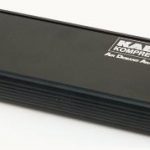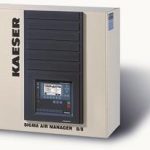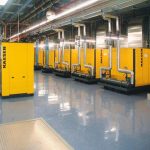In chemical and process technologies the demand for high-quality process and control air is increasing. Modern compressed air systems must therefore not only deliver maximum reliability with regard to air volume and quantity, but also provide outstanding performance and efficiency. The Sigma Air Manager compressed air management system enables unrivalled control and system flexibility to ensure an efficient supply of quality compressed air.
Erwin Ruppelt
Many people still regard compressed air systems as a collection of unconnected individual components and, in particular, tend to just focus on the compressor. They ignore the wider context and fail to view the system as a whole. The role of the air treatment equipment, system controller, air distribution network and even the user should not be underestimated, however, as they all have a significant effect on system reliability and performance. When it comes to energy costs, users are usually able to quote the price per kilowatt electricity. Yet if asked how much each cubic metre of compressed air costs, then roughly 8 out of 10 will not be able to provide a satisfactory answer. This is due in part to many companies still being more concerned with the initial investment cost of a compressed air system rather than taking the long-term operating costs into consideration. However, it nevertheless remains a fact that even with a perfectly optimised compressed air system, the energy costs for compressed air production amount to nearly 70 % of the total life cycle costs, whereas the initial purchase investment (without installation) accounts for only 18 %.
Study in energy saving
The results of an EU study on energy saving in compressed air systems, carried out and published in 2001 as part of the European “Save II” project, tell their own tale: of the 80,000 million kWh required to produce compressed air in Europe since the beginning of the decade, more than 32 % can be saved through improvements in efficiency. That amounts to an annual saving of 2,500 million euros when calculated at average European electricity prices. A further fundamental finding of the study was that such potential savings cannot be realised simply by improving individual components within the system, but only through an integrated approach to system optimisation. The reason for this is that most non-optimised systems show weaknesses in all areas. Almost as soon as the study was published, some providers were promoting individual products such as workplace compressors, variable-speed compressors or air treatment components that would supposedly enable energy savings of 30 or even 40 %. It must be remembered, however, that integrating a new product into an existing system simply repeats the mistakes of the past. It is precisely systems such as these, lacking in a coherent overall concept, which often waste large amounts of energy. They are characterised by inadequately coordinated and isolated components, inefficient and in many cases too complex control systems as well as piping systems which are incorrectly sized and poorly maintained.
No investment without analysis
Efficient analysis procedures and equipment from Kaeser, for example, can help to quickly estimate actual compressed air costs and identify system areas which are causing energy losses. Key data such as pressure, pressure losses, air consumption and air leakages can be gathered, analysed and documented in a matter of just a few days. This information can then be used to calculate potential energy savings and determine appropriate measures for system optimisation. When considering a new investment in a compressed air system, it is advisable to first gain a detailed overall picture of the existing system. The following steps are recommended:
- Assessment of the compressed air consumption, compressed air quality and time-dependent operation for all compressed air-consuming equipment
- Determination of the location, material type and sizing of the main air supply lines
- Preparation of a schematic diagram of the air production and treatment systems
- Performance of a detailed analysis of all compressed air-consuming equipment using data loggers over a period of at least ten days
An evaluation of this data, which also includes information about leakage losses, provides the key facts required to calculate the actual compressed air costs. The air demand analysis shows in detail whether the existing air distribution network still has sufficient capacity and whether there are any potential problems with regard to pressure and leakage losses. It additionally detects whether compressed air quality is affected by contamination in the air distribution network.
Synergy effects exploited
In order to be able to take advantage of synergy effects and facilitate subsequent planning, it is important that as many compressed air-consuming systems as possible operate at the same pressure. Decentralised, stand-alone systems have the disadvantage that they are forced to manage with smaller air distribution piping. This results in less efficient capacity utilisation and higher energy consumption irrespective of whether or not speed-controlled compressors are used. Decentralised compressor systems, network sections operating with different pressures or air qualities and the use of small, oil-free compressors for specific processes should therefore only be considered in exceptional circumstances. In the long term, such solutions almost always drive up energy costs and unnecessarily restrict flexibility with regard to possible future plans to expand production or modernise the system. Furthermore, the size of the individual compressors must be perfectly matched to enable an efficient master control system, such as the PC-based Sigma Air Manager from Kaeser, to select the correct compressor combination at any given time. The compressed air treatment system also has to be precisely tailored to the compressor performance. Whether or not the peak-load compressors should be speed-controlled needs to be decided with reference to an application-specific efficiency calculation.
Master control
Using the full potential of modern PC and Internet technology, the Sigma Air Manager master controller provides comprehensive compressed air system management. With clear data visualisation and an energy-saving pressure band control method (which reduces the cut-in/cut-out frequency to a minimum), the system coordinates operation of the individual, differently sized compressors within the compressor package to ensure optimal system performance. Efficient pressure control to within ±0.1 bar prevents unnecessarily high pressure at the point of use, which is particularly beneficial as each 1 bar reduction in maximum operating pressure translates into a 6 % reduction in energy consumption. The clearly structured graphic display can show information in 30 languages, while intuitive text menus make for simple operation. Sigma Air Control basic technology allows current system operating data, mes-sages and alarms to be viewed at any time using a web browser. Compressor installations equipped with a Sigma Air Manager can also be seamlessly integrated into a teleservice facility. Using standard modem interfaces, teleservicing enables all relevant information to be instantaneously sent by text message or the Internet to a central service centre. Demand-oriented preventive maintenance is therefore possible by remote diagnosis, thus further improving compressed air availability. Moreover, the long-term analysis tool Sigma Air Control plus allows data such as load and no-load phases, network pressure, energy consumption and compressor duty cycles to be tracked over the course of a year. This information can be evaluated from various viewpoints and provides a detailed insight into a system’s compressed air consumption.
cpp 435
More information on compressed air management
Search engine for compressors
Share:









